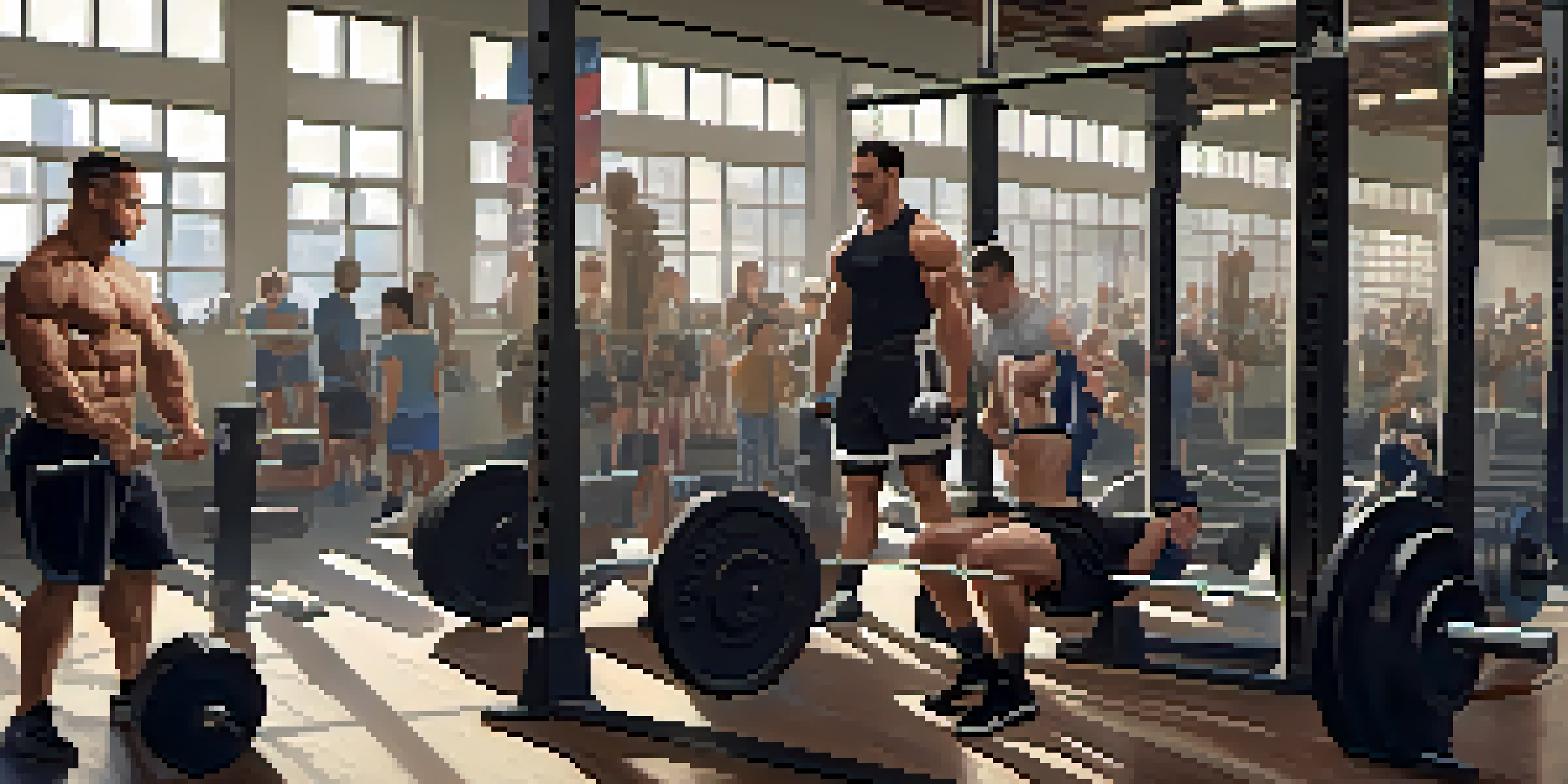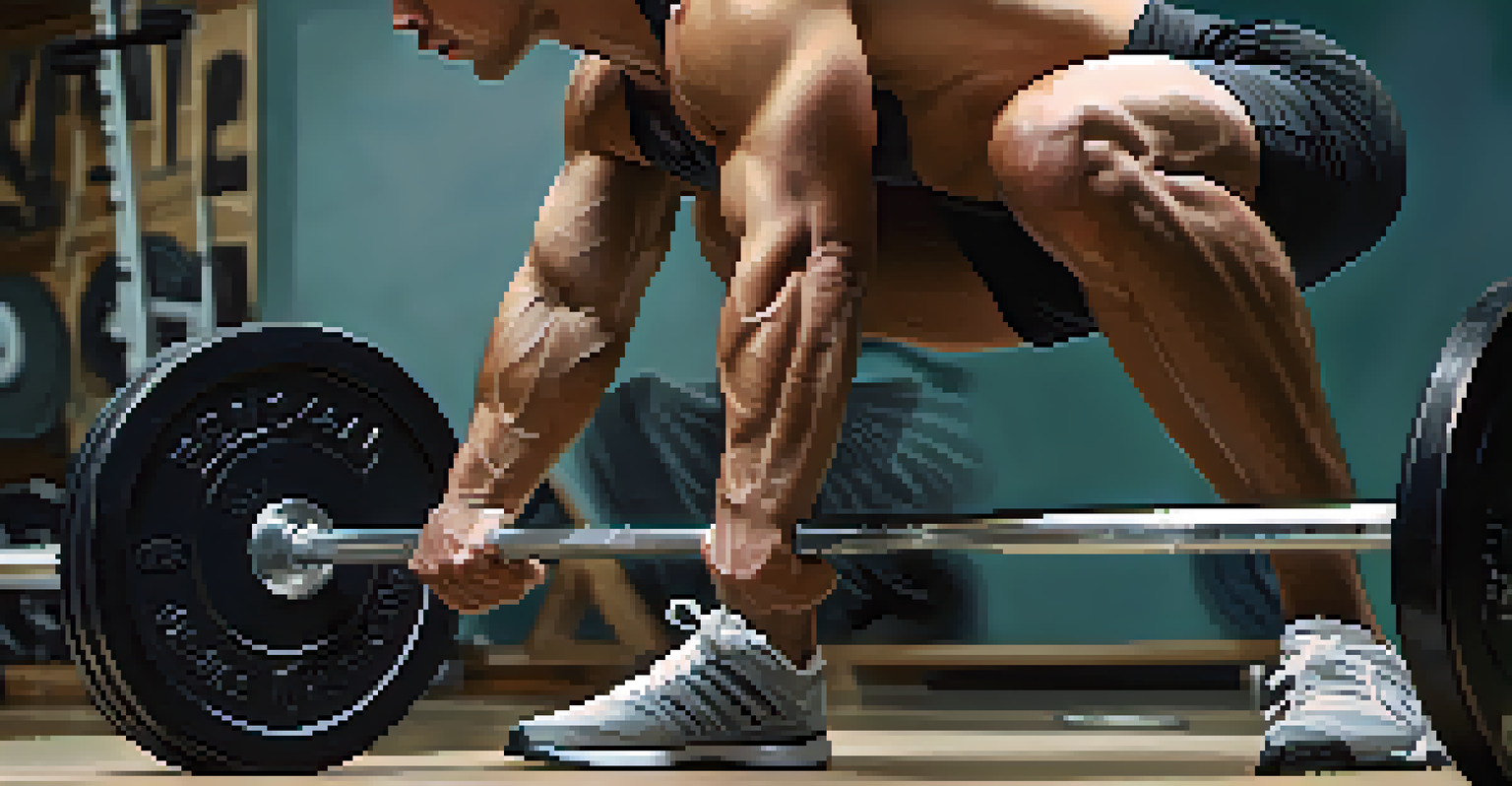Powerlifting Techniques Enhancing Functional Movement Patterns

Understanding Functional Movement Patterns in Daily Life
Functional movement patterns are the fundamental movements we perform daily, such as squatting, lifting, and bending. These movements are crucial for maintaining a healthy lifestyle and preventing injuries, especially as we age. By understanding these patterns, we can better tailor our training to improve overall body mechanics and efficiency.
Strength does not come from physical capacity. It comes from an indomitable will.
Incorporating exercises that mimic these patterns not only strengthens the right muscles but also enhances coordination and balance. For instance, when you perform a squat, you're not just building leg strength; you're also training your body to stabilize and control its movement, which is vital for everyday tasks like picking up groceries.
Ultimately, improving your functional movement patterns means you can perform daily activities with greater ease and confidence. This makes powerlifting techniques particularly valuable, as they promote strength and stability while addressing these essential movements.
Key Powerlifting Techniques to Enhance Strength
Powerlifting is composed of three main lifts: squat, bench press, and deadlift. Each of these lifts plays a significant role in developing strength and stability across various muscle groups. For instance, the squat not only targets your legs but also engages your core and back, making it a comprehensive strength builder.

When executed properly, these powerlifting techniques can significantly enhance your functional strength. By focusing on compound movements, you train multiple muscle groups simultaneously, which translates well to real-life activities. Think about how lifting heavy boxes requires the same muscle coordination as performing a deadlift.
Functional Movements Matter
Understanding and enhancing functional movement patterns through exercises like squats, deadlifts, and bench presses can improve daily activities and prevent injuries.
Moreover, incorporating powerlifting into your routine can lead to better overall body mechanics. This is because these lifts emphasize proper form and alignment, which are critical for minimizing the risk of injury and maximizing performance in daily tasks.
The Squat: Building Lower Body Strength and Stability
The squat is one of the most effective powerlifting techniques for enhancing lower body strength. It primarily targets the quadriceps, hamstrings, and glutes while also engaging the core for stability. This makes it an excellent exercise for improving your ability to perform functional movements like sitting down and standing up.
The only bad workout is the one that didn't happen.
When you squat correctly, you teach your body to maintain balance and control, which is essential for activities such as climbing stairs or lifting objects from a lower position. Picture a child learning to squat; they instinctively know how to use their hips and knees to achieve the movement, which is a natural and functional way to engage their muscles.
Incorporating weighted squats into your training can further enhance your strength. As you progress, you'll find that everyday movements become easier, ultimately leading to improved functionality in your daily life.
The Deadlift: Enhancing Posterior Chain Strength
The deadlift is another cornerstone of powerlifting that plays a vital role in functional movement. It primarily targets the posterior chain, including the glutes, hamstrings, and lower back. Strengthening these muscles is crucial, as they are often involved in various everyday tasks, such as lifting heavy objects off the ground.
One of the most significant benefits of the deadlift is its ability to teach proper hip hinge mechanics. Many people struggle with bending over to pick things up, leading to poor posture and potential injury. By practicing deadlifts, you reinforce the correct way to engage your hips and protect your back during these movements.
Powerlifting Builds Strength
Incorporating powerlifting techniques into your routine enhances overall body mechanics and strength, making everyday tasks easier and more efficient.
As with the squat, incorporating deadlifts into your training routine translates directly to functional improvements in daily life. You'll notice a boost in your overall strength, making everyday activities feel less strenuous and more manageable.
The Bench Press: Strengthening Upper Body Functionality
The bench press is primarily known for building upper body strength, targeting the chest, shoulders, and triceps. While it may not seem as directly relevant to functional movement as squats or deadlifts, it plays a crucial role in developing the strength necessary for pushing movements. Think about pushing heavy doors or lifting objects overhead—those actions require a solid upper body foundation.
By incorporating the bench press into your routine, you enhance your upper body stability and strength, which can improve your overall functional capacity. This exercise also helps reinforce proper shoulder mechanics, which are crucial for maintaining good posture and preventing injuries during everyday activities.
Additionally, having a strong upper body can contribute to better performance in other functional movements that require pushing or lifting. As you build strength through the bench press, you’ll likely notice improvements in related tasks, making your day-to-day life easier and more efficient.
Integrating Powerlifting into a Functional Training Program
To fully reap the benefits of powerlifting for functional movement, it's essential to integrate these techniques into a well-rounded training program. This means combining powerlifting with other forms of exercise, such as mobility training and cardiovascular conditioning. By doing so, you create a balanced routine that promotes strength, flexibility, and overall fitness.
For instance, pairing powerlifting sessions with mobility work can help improve your range of motion and prevent injuries. This could involve exercises such as dynamic stretches or yoga, which complement the strength gained through powerlifting. Think of it as blending two essential ingredients to create a nutritious meal.
Long-Term Gains from Powerlifting
Committing to powerlifting not only boosts physical capabilities but also fosters confidence and a supportive community among lifters.
Moreover, integrating functional movements with powerlifting can enhance your overall athleticism. Whether you’re an athlete or simply looking to improve your everyday functionality, this approach will help you achieve a stronger, more capable body that can handle various physical demands.
Monitoring Progress and Adjusting Techniques
As with any training program, monitoring your progress and adjusting your techniques are crucial for success in powerlifting. This involves regularly assessing your strength levels and ensuring that your form remains consistent. Paying attention to how your body feels during and after workouts can provide valuable insights into your training effectiveness.
Using tools like training logs can help track your progress over time. Recording your lifts, reps, and any adjustments made allows you to visualize your gains and identify areas for improvement. This not only keeps you motivated but also helps you make informed decisions about your training approach.

Additionally, seeking feedback from a coach or experienced lifter can be beneficial. They can provide insights into your technique, offering tips to enhance your lifts and functional movement patterns. Remember, continuous improvement is the key to achieving long-term success in both powerlifting and functional training.
The Long-Term Benefits of Powerlifting for Functional Movement
Incorporating powerlifting techniques into your fitness routine can yield long-term benefits for your functional movement patterns. Improved strength, stability, and coordination are just a few advantages you can expect to see over time. These benefits can greatly enhance your quality of life, making daily tasks easier and more enjoyable.
Moreover, the confidence gained from mastering powerlifting techniques often translates into other areas of life. When you realize you can lift heavier weights and perform challenging movements, you may be more inclined to tackle other physical activities, from hiking to sports. This newfound confidence can positively impact your overall well-being.
Ultimately, the long-term commitment to powerlifting not only bolsters your physical capabilities but also fosters a sense of community and support among fellow lifters. This engaging environment encourages growth, motivation, and a shared passion for strength training, making your fitness journey all the more rewarding.